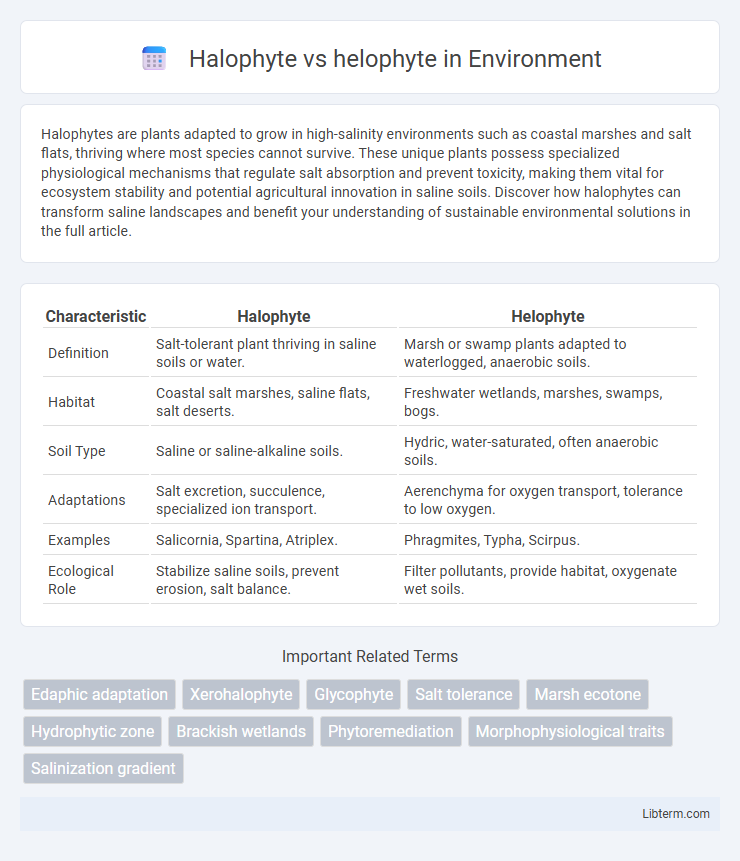Halophytes are plants adapted to grow in high-salinity environments such as coastal marshes and salt flats, thriving where most species cannot survive. These unique plants possess specialized physiological mechanisms that regulate salt absorption and prevent toxicity, making them vital for ecosystem stability and potential agricultural innovation in saline soils. Discover how halophytes can transform saline landscapes and benefit your understanding of sustainable environmental solutions in the full article.
Table of Comparison
| Characteristic | Halophyte | Helophyte |
|---|---|---|
| Definition | Salt-tolerant plant thriving in saline soils or water. | Marsh or swamp plants adapted to waterlogged, anaerobic soils. |
| Habitat | Coastal salt marshes, saline flats, salt deserts. | Freshwater wetlands, marshes, swamps, bogs. |
| Soil Type | Saline or saline-alkaline soils. | Hydric, water-saturated, often anaerobic soils. |
| Adaptations | Salt excretion, succulence, specialized ion transport. | Aerenchyma for oxygen transport, tolerance to low oxygen. |
| Examples | Salicornia, Spartina, Atriplex. | Phragmites, Typha, Scirpus. |
| Ecological Role | Stabilize saline soils, prevent erosion, salt balance. | Filter pollutants, provide habitat, oxygenate wet soils. |
Introduction to Halophytes and Helophytes
Halophytes thrive in high-salinity environments such as salt marshes and coastal areas, adapting through specialized salt-excreting glands and succulent leaves to maintain water balance. Helophytes primarily inhabit saturated soils in wetlands, exhibiting adaptations like aerenchyma tissue for oxygen transport in anaerobic conditions and robust root systems to stabilize marsh soils. Both plant types play crucial ecological roles by supporting biodiversity and contributing to habitat formation in saline and freshwater ecosystems respectively.
Defining Halophytes: Characteristics and Adaptations
Halophytes are salt-tolerant plants adapted to thrive in saline environments such as salt marshes, coastal areas, and saline soils by employing specialized mechanisms like salt excretion, succulence, and osmotic regulation. Their physiological traits include efficient ion compartmentalization and the synthesis of compatible solutes to maintain cellular homeostasis under high salinity stress. Unlike helophytes, which primarily grow in waterlogged, freshwater habitats with low salinity, halophytes exhibit unique morphological and biochemical adaptations enabling survival in harsh saline conditions.
Helophytes Explained: Key Features and Adaptations
Helophytes are aquatic plants adapted to grow in marshy or waterlogged soils, commonly found in wetlands and shallow water environments, distinguished by their ability to tolerate low oxygen levels in saturated soils. Key features of helophytes include specialized aerenchyma tissues that facilitate oxygen transport from aerial parts to submerged roots, and robust rhizomes enabling nutrient storage and vegetative propagation. These plants exhibit adaptations like extensive root systems for anchorage and nutrient absorption in anaerobic conditions, crucial for maintaining wetland ecosystem stability and water purification functions.
Ecological Niches: Where Halophytes and Helophytes Thrive
Halophytes thrive in saline environments such as salt marshes, coastal regions, and saline soils, where they have adapted to high salt concentrations that limit plant growth. Helophytes are primarily found in freshwater wetlands, marshes, and along the edges of ponds and rivers, where they grow in waterlogged, oxygen-poor soils rich in organic matter. These distinct ecological niches reflect the specialized adaptations of halophytes to saline stress and helophytes to saturated, anaerobic conditions.
Salt Tolerance Mechanisms in Halophytes
Halophytes exhibit specialized salt tolerance mechanisms such as salt ion compartmentalization within vacuoles, secretion of excess salts through specialized salt glands, and osmotic adjustment via accumulation of compatible solutes like proline and glycine betaine. These adaptations enable halophytes to thrive in high-salinity environments by mitigating ionic toxicity and osmotic stress. In contrast, helophytes primarily inhabit waterlogged or marshy soils and lack specialized salt tolerance strategies, making them less capable of surviving in saline conditions.
Waterlogged Environment Adaptations in Helophytes
Helophytes exhibit specialized adaptations for thriving in waterlogged environments, such as aerenchyma tissue that facilitates efficient oxygen transport to submerged roots, enabling survival in low-oxygen soils. These plants often develop adventitious roots and possess radial oxygen loss barriers to minimize toxic effects from reduced soil compounds. In contrast, halophytes primarily adapt to high salinity rather than prolonged water saturation, focusing on salt excretion and sequestration mechanisms.
Examples of Common Halophyte Species
Salicornia europaea, Atriplex halimus, and Spartina alterniflora are common examples of halophyte species thriving in high-salinity environments such as salt marshes and coastal areas. These halophytes have specialized salt-excreting glands and succulent leaves that enable survival in saline soils, distinguishing them from helophytes, which primarily grow in freshwater wetlands. Studying halophytes furthers understanding of plant salt-tolerance mechanisms and supports saline agriculture development.
Examples of Typical Helophyte Plants
Typical helophyte plants include cattails (Typha spp.), reeds (Phragmites australis), and bulrushes (Schoenoplectus spp.), which thrive in freshwater wetlands and marshes. These plants are adapted to waterlogged soils with their extensive root systems that tolerate low oxygen conditions. Unlike halophytes, which are salt-tolerant and found in saline environments, helophytes primarily inhabit freshwater ecosystems and play a crucial role in nutrient cycling and habitat structure.
Importance and Applications of Halophytes and Helophytes
Halophytes, salt-tolerant plants thriving in saline environments, play a crucial role in soil stabilization, saline agriculture, and bioremediation of salt-affected lands, contributing to sustainable crop production and ecosystem restoration. Helophytes, rooted in waterlogged soils with emergent shoots, are vital for wastewater treatment and constructed wetlands due to their ability to filter pollutants and improve water quality. Both plant types support biodiversity, enhance habitat resilience, and offer innovative solutions for environmental management and climate change adaptation.
Key Differences Between Halophytes and Helophytes
Halophytes are salt-tolerant plants adapted to saline environments such as salt marshes and coastal regions, whereas helophytes thrive in freshwater wetlands, growing in saturated soils or shallow water. Halophytes possess specialized salt-excreting glands or succulent leaves to manage high salinity, while helophytes feature extensive root systems for oxygen uptake in anoxic, waterlogged soils. The primary ecological distinction lies in halophytes' ability to survive high salt concentrations, contrasting with helophytes' adaptation to low-salinity, oxygen-deficient aquatic habitats.
Halophyte Infographic

 libterm.com
libterm.com